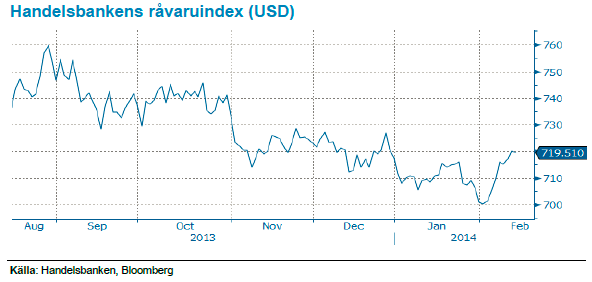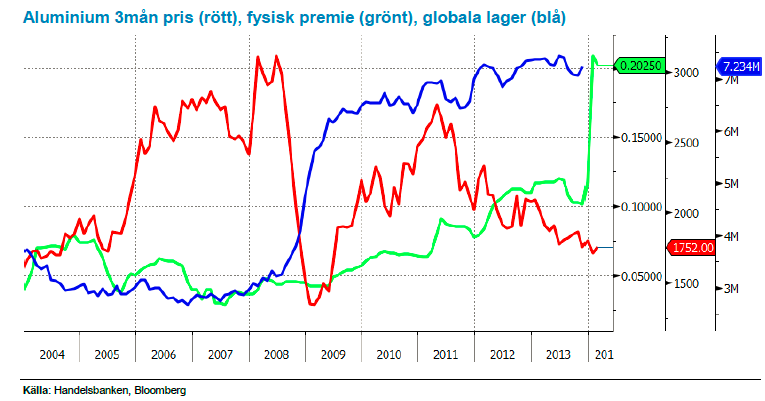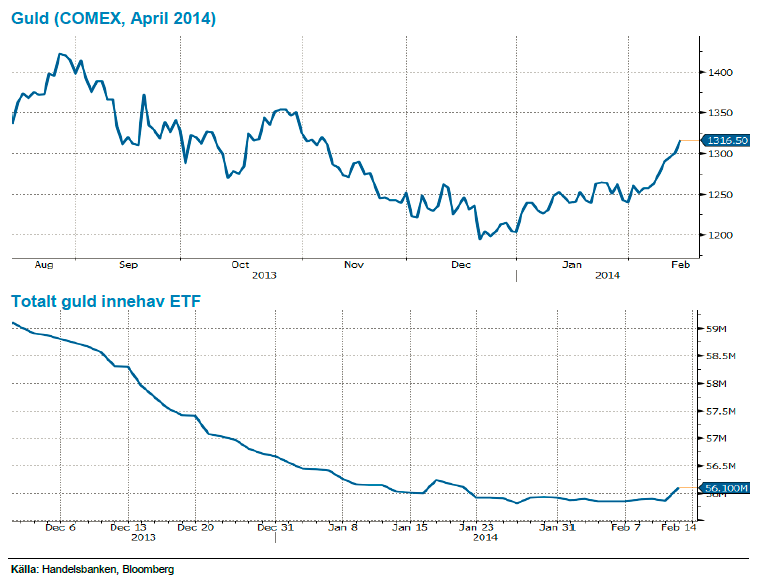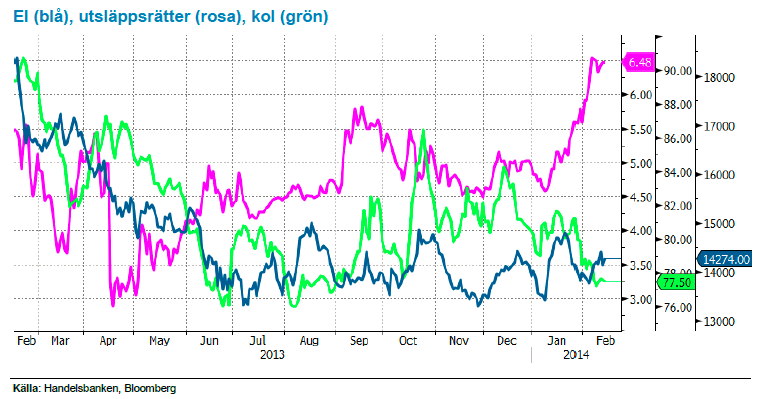Analys
SHB Råvarubrevet 14 februari 2014

Råvaror allmänt: Yrvädret kom en februariafton
 Optimismen i början av året fick sig en törn, men har kommit tillbaka relativt snabbt. Börser i väst har återhämtat den största delen av fallet och marknaden drar slutsatsen att den senaste tidens överraskande svaghet i amerikansk data (ISM och payrolls), är tillfällig. I den mån vädret ligger bakom avmattningen i data skulle effekten kunna bestå även i februari. Vi tror dock att investerare kommer att vara betydligt mer obekväma med en sådan tolkning om både sysselsättningsökningen och ISM skulle ligga kvar på januarinivåer. Därmed blir ISM och sysselsättningsdata än mer avgörande för marknaden i samband med release i början av mars.
Optimismen i början av året fick sig en törn, men har kommit tillbaka relativt snabbt. Börser i väst har återhämtat den största delen av fallet och marknaden drar slutsatsen att den senaste tidens överraskande svaghet i amerikansk data (ISM och payrolls), är tillfällig. I den mån vädret ligger bakom avmattningen i data skulle effekten kunna bestå även i februari. Vi tror dock att investerare kommer att vara betydligt mer obekväma med en sådan tolkning om både sysselsättningsökningen och ISM skulle ligga kvar på januarinivåer. Därmed blir ISM och sysselsättningsdata än mer avgörande för marknaden i samband med release i början av mars.
I samband med Yellens jungfrutal i veckan indikerade hon att betydligt mer än några låga sysselsättningssiffror krävs för att Fed skall avvika från inslagen taper-linje (vilket bekräftade en av hörnpelarna i vår vändning till köp på guld). Oron för tillväxtmarknader finns kvar, men marknaden drar slutsatsen att de länder som är har de tydligaste problemen (Argentina, Turkiet, Sydafrika) är för små finansiellt och realt för att gunga den globala båten.
Förutsättningarna för en amerikanskt ledd global återhämtning är på pappret bättre än på länge. De senaste årens stigande tillgångspriser och kraftiga ihopspreadningar talar för att den sedvanliga feedback-loopen ger en skjuts in i realekonomin. Dessutom är finanspolitiken en mindre motvind jämfört med de senaste åren. Till och med euroområdet har överraskningspotential mot bakgrund av den signifikanta lättnaden i finansiella förhållanden som har blivit följden av ECB:s backstop. I Kina är det dock slagigt, importdata för koppar, järnmalm, soja och olja kom under veckan på 3 års högsta för januari månad. Tillsammans med en motstridig uppgift om starkare än väntad export/import anar vi viss nyårsledighetseffekt i data. Data under mars kommer bli ovanligt viktig, både från Kina och USA.
Basmetaller: Kinas importdata på 3 års högsta
Basmetallerna fortsätter att handlas upp något även denna vecka. Under februari har vårt basmetallsindex stigit med 2,2 %. Importdata för januari från Kina visar på rekordhög import på bland annat koppar. Risk finns dock att den höga siffran har påverkats av kinas nyår då tullverket pappersarbetet forcerats inför nyårsledigheten. Vi väntar med andra ord att februaris import kommer in betydligt svagare.
Väldigt intressant utveckling på aluminium där den fysiska premien (i grönt nedan) skjutit iväg som ett resultat av höga lager (blå kurva nedan 7.234 miljoner ton nedan) / långa köer på grund av de contangoaffärer och börsens svårigheter att lösa flaskhalsarna som vi tidigare skrivit om. Samtidigt ser vi en starkare efterfrågan, framför allt i USA, där flertalet hamnat korta efter att man dragit ned närmare 600,000 ton kapacitet (USA som producerade ca 4.9 miljoner ton 2013 står för 10% av den gloabal produktionen där Kina är ledande med 21.9 miljoner ton rapporterat och uppskattningsvis 2.4 miljoner ton orapporterat. Vi förväntar oss att aluminium stiger något under året men att det stora överskottet först börjar betas av mot slutet av 2015. Såväl Rusal, Alcoa och Rio Tinto har aviserat neddragningar vilket ger stöd för priset.
Låga prisnivåer, exportstopp av oförädlad nickelmalm från Indonesien och det faktum att 40 % av gruvorna går med förlust på dagens prisnivå. Vi tror på: LONG NICKEL H
Ädelmetaller: Ytterligare en bra vecka för guldet
Vi noterar en bra vecka för samtliga ädelmetaller, guldet har t. ex. stigit med drygt 3,2 procent sedan förra veckans brev. Vi är ju sedan ett par veckor nu positiva på ädelmetaller – särskilt guldet – drivet av ett par orsaker. Vårt resonemang – som dessutom mynnade ut i ett Trading Case den 31 januari – baserades på att konsensus blivit negativa på guld (det brukar löna sig att gå emot strömmen), att Feds begynnande åtstramning inte haft negativ påverkan på guldet, och att utflödena ur guld ETF-er verkar ha avstannat. Vidare trodde vi att den uppseglande emerging markets-oron kunde leda till ”säkerhamn” flöden in i guld, och att Indien och Kina nu kan komma att köpa en något större del av den fysiska produktionen.
När vi nu tittar på dessa faktorer så noterar vi att – som nämnts i inledningen av brevet – Yellens tal i veckan, som signalerade åtstramning, inte hade negativ påverkan på guldet denna gång heller, och att flödet till ETF för första gången på väldigt länge varit starkt positivt. Därtill har en återhämtning i den globala riskaptiten – som lett till börsuppgångar världen över, och återhämtning i emerging-valutor – inte heller skapat någon nedgång i guldpriset. Vi är sammantaget fortsatt starka i vår positiva syn efter ytterligare en vecka med positiv prisutveckling.
Efter en lång tid av negativ vy för guldet har vi bytt fot och tror på stigande pris. Vi tror på: LONG GULD H
Energi: Elpriset tyngs av det milda vädret
Det räcker med att titta ut genom fönstret så förstår ni hur resten av elmarknaden resonerar, vädret är just nu den styrande faktorn och prognoserna pekar på fortsatt våta och milda scenarion vilket gör att vi närmar oss den tidigare lågpunkten för Q2-14. Vi har en svag fysisk marknad där spoten överraskar negativt mot slutet av veckan samt en nedskrivning av vattenvärdena i nivå med var brytpriset ligger. Utsläppsrätterna, rosa i graf, som stigit 30 procent under året efter mer konkreta förslag kring att minska överskottet faller tillbaka något samtidigt som kolet, i grönt nedan, handlas oförändrat. Vi behåller en neutral vy i väntan på att någon av ovan nämnda faktorer förändras.
Oljemarknaden handlas oförändrat över veckan då amerikanska arbetslöshetssiffror balanseras av vikande Libyska produktionssiffror, återigen ned till 450kbpd efter protester vid oljefälten, samt torsdagens rapport från International Energy Agency som nu är något mer positiv. IEA rapporten visar att lagren i OECD länderna föll 1.5 procent under förra kvartalet som ett resultat av en ökad efterfrågan vilket i så fall skulle innebära det största kvartalsfallet sedan 1999 för lagren. Tidigare i veckan har även OPEC och EIA reviderat upp sina prognoser för efterfrågan under 2014. På utbudssidan minskar både Irak och Saudi något (9.82 mfpd i december), säkerligen med stöd från Libyen som ändå väntas nå en produktion om 770kfpd under året. Det skulle innebära att reservkapaciteten ökar till 1.92 mfpd vilket är en förbättring från nuvarande ca 1.5 mfpd. Summa summarum, vi står fast vid vår vy att oljan kommer att vara fortsatt köpvärd ned mot 106 med en begränsad potential uppemot 111 dollar och där en positiv rullningsavkastning tack vare terminsrabatten motiverar att ligga kvar.
Vi tror att det kommer ges möjligheter till god avkastning i denna range-baserade handel där oljan är köpvärd var gång den kommer ned på lägre nivåer. Vi tror på: LONG OLJA H
Handelsbankens råvaruindex
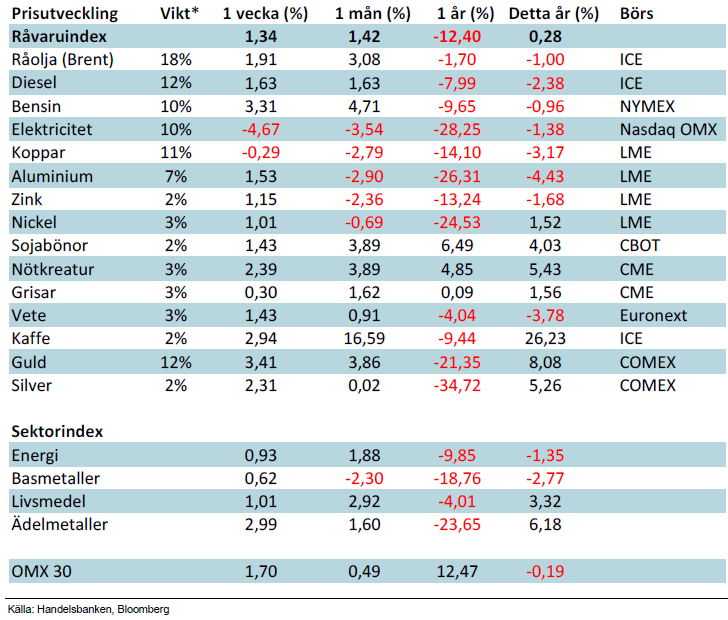
*Uppdaterade vikter från 29 november 2013
Handelsbankens råvaruindex består av de underliggande indexen för respektive råvara. Vikterna är bestämda till hälften från värdet av nordisk produktion (globala produktionen för sektorindex) och till hälften från likviditeten i terminskontrakten.
[box]SHB Råvarubrevet är producerat av Handelsbanken och publiceras i samarbete och med tillstånd på Råvarumarknaden.se[/box]
Ansvarsbegränsning
Detta material är producerat av Svenska Handelsbanken AB (publ) i fortsättningen kallad Handelsbanken. De som arbetar med innehållet är inte analytiker och materialet är inte oberoende investeringsanalys. Innehållet är uteslutande avsett för kunder i Sverige. Syftet är att ge en allmän information till Handelsbankens kunder och utgör inte ett personligt investeringsråd eller en personlig rekommendation. Informationen ska inte ensamt utgöra underlag för investeringsbeslut. Kunder bör inhämta råd från sina rådgivare och basera sina investeringsbeslut utifrån egen erfarenhet.
Informationen i materialet kan ändras och också avvika från de åsikter som uttrycks i oberoende investeringsanalyser från Handelsbanken. Informationen grundar sig på allmänt tillgänglig information och är hämtad från källor som bedöms som tillförlitliga, men riktigheten kan inte garanteras och informationen kan vara ofullständig eller nedkortad. Ingen del av förslaget får reproduceras eller distribueras till någon annan person utan att Handelsbanken dessförinnan lämnat sitt skriftliga medgivande. Handelsbanken ansvarar inte för att materialet används på ett sätt som strider mot förbudet mot vidarebefordran eller offentliggörs i strid med bankens regler.
Analys
Also OPEC+ wants to get compensation for inflation

Brent crude has fallen USD 3/b since the peak of Iran-Israel concerns last week. Still lots of talk about significant Mid-East risk premium in the current oil price. But OPEC+ is in no way anywhere close to loosing control of the oil market. Thus what will really matter is what OPEC+ decides to do in June with respect to production in Q3-24 and the market knows this very well. Saudi Arabia’s social cost-break-even is estimated at USD 100/b today. Also Saudi Arabia’s purse is hurt by 21% US inflation since Jan 2020. Saudi needs more money to make ends meet. Why shouldn’t they get a higher nominal pay as everyone else. Saudi will ask for it

Brent is down USD 3/b vs. last week as the immediate risk for Iran-Israel has faded. But risk is far from over says experts. The Brent crude oil price has fallen 3% to now USD 87.3/b since it became clear that Israel was willing to restrain itself with only a muted counter attack versus Israel while Iran at the same time totally played down the counterattack by Israel. The hope now is of course that that was the end of it. The real fear has now receded for the scenario where Israeli and Iranian exchanges of rockets and drones would escalate to a point where also the US is dragged into it with Mid East oil supply being hurt in the end. Not everyone are as optimistic. Professor Meir Javedanfar who teaches Iranian-Israeli studies in Israel instead judges that ”this is just the beginning” and that they sooner or later will confront each other again according to NYT. While the the tension between Iran and Israel has faded significantly, the pain and anger spiraling out of destruction of Gaza will however close to guarantee that bombs and military strifes will take place left, right and center in the Middle East going forward.
Also OPEC+ wants to get paid. At the start of 2020 the 20 year inflation adjusted average Brent crude price stood at USD 76.6/b. If we keep the averaging period fixed and move forward till today that inflation adjusted average has risen to USD 92.5/b. So when OPEC looks in its purse and income stream it today needs a 21% higher oil price than in January 2020 in order to make ends meet and OPEC(+) is working hard to get it.
Much talk about Mid-East risk premium of USD 5-10-25/b. But OPEC+ is in control so why does it matter. There is much talk these days that there is a significant risk premium in Brent crude these days and that it could evaporate if the erratic state of the Middle East as well as Ukraine/Russia settles down. With the latest gains in US oil inventories one could maybe argue that there is a USD 5/b risk premium versus total US commercial crude and product inventories in the Brent crude oil price today. But what really matters for the oil price is what OPEC+ decides to do in June with respect to Q3-24 production. We are in no doubt that the group will steer this market to where they want it also in Q3-24. If there is a little bit too much oil in the market versus demand then they will trim supply accordingly.
Also OPEC+ wants to make ends meet. The 20-year real average Brent price from 2000 to 2019 stood at USD 76.6/b in Jan 2020. That same averaging period is today at USD 92.5/b in today’s money value. OPEC+ needs a higher nominal price to make ends meet and they will work hard to get it.
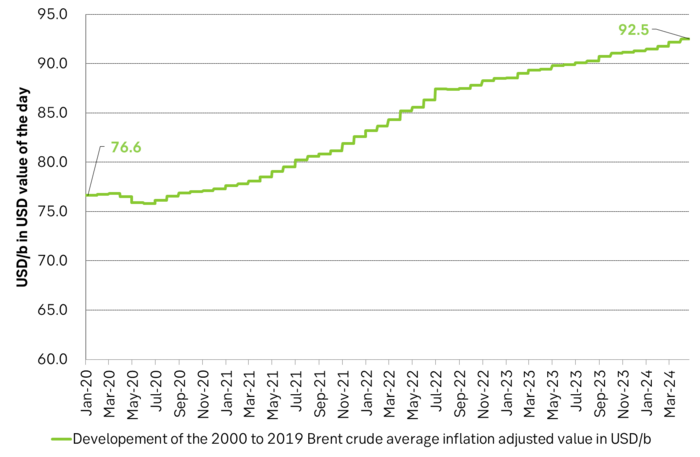
Inflation adjusted Brent crude price versus total US commercial crude and product stocks. A bit above the regression line. Maybe USD 5/b risk premium. But type of inventories matter. Latest big gains were in Propane and Other oils and not so much in crude and products

Total US commercial crude and product stocks usually rise by 4-5 m b per week this time of year. Gains have been very strong lately, but mostly in Propane and Other oils

Last week’s US inventory data. Big rise of 10 m b in commercial inventories. What really stands out is the big gains in Propane and Other oils
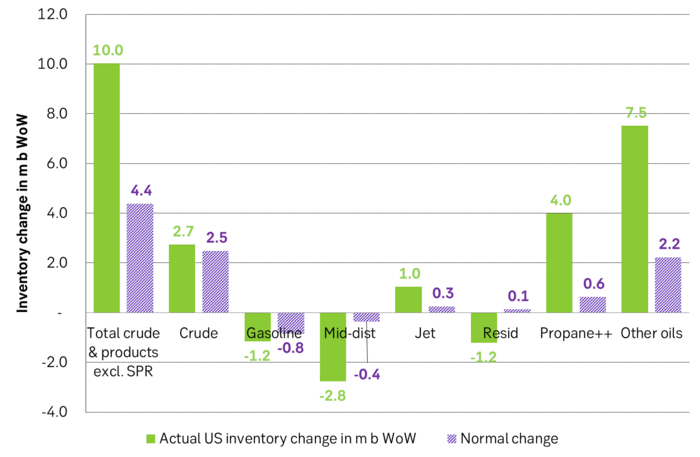
Take actual changes minus normal seasonal changes we find that US commercial crude and regular products like diesel, gasoline, jet and bunker oil actually fell 3 m b versus normal change.

Analys
Nat gas to EUA correlation will likely switch to negative in 2026/27 onward

Historically positive Nat gas to EUA correlation will likely switch to negative in 2026/27 onward

Historically there has been a strong, positive correlation between EUAs and nat gas prices. That correlation is still fully intact and possibly even stronger than ever as traders increasingly takes this correlation as a given with possible amplification through trading action.
The correlation broke down in 2022 as nat gas prices went ballistic but overall the relationship has been very strong for quite a few years.
The correlation between nat gas and EUAs should be positive as long as there is a dynamical mix of coal and gas in EU power sector and the EUA market is neither too tight nor too weak:
Nat gas price UP => ”you go black” by using more coal => higher emissions => EUA price UP
But in the future we’ll go beyond the dynamically capacity to flex between nat gas and coal. As the EUA price moves yet higher along with a tightening carbon market the dynamical coal to gas flex will max out. The EUA price will then trade significantly above where this flex technically will occur. There will still be quite a few coal fired power plants running since they are needed for grid stability and supply amid constrained local grids.
As it looks now we still have such overall coal to gas flex in 2024 and partially in 2025, but come 2026 it could be all maxed out. At least if we look at implied pricing on the forward curves where the forward EUA price for 2026 and 2027 are trading way above technical coal to gas differentials. The current forward pricing implications matches well with what we theoretically expect to see as the EUA market gets tighter and marginal abatement moves from the power sector to the industrial sector. The EUA price should then trade up and way above the technical coal to gas differentials. That is also what we see in current forward prices for 2026 and 2027.
The correlation between nat gas and EUAs should then (2026/27 onward) switch from positive to negative. What is left of coal in the power mix will then no longer be dynamically involved versus nat gas and EUAs. The overall power price will then be ruled by EUA prices, nat gas prices and renewable penetration. There will be pockets with high cost power in the geographical points where there are no other alternatives than coal.
The EUA price is an added cost of energy as long as we consume fossil energy. Thus both today and in future years we’ll have the following as long as we consume fossil energy:
EUA price UP => Pain for consumers of energy => lower energy consumption, faster implementation of energy efficiency and renewable energy => lower emissions
The whole idea with the EUA price is after all that emissions goes down when the EUA price goes up. Either due to reduced energy consumption directly, accelerated energy efficiency measures or faster switch to renewable energy etc.
Let’s say that the coal to gas flex is maxed out with an EUA price way above the technical coal to gas differentials in 2026/27 and later. If the nat gas price then goes up it will no longer be an option to ”go black” and use more coal as the distance to that is too far away price vise due to a tight carbon market and a high EUA price. We’ll then instead have that:
Nat gas higher => higher energy costs with pain for consumers => weaker nat gas / energy demand & stronger drive for energy efficiency implementation & stronger drive for more non-fossil energy => lower emissions => EUA price lower
And if nat gas prices goes down it will give an incentive to consume more nat gas and thus emit more CO2:
Cheaper nat gas => Cheaper energy costs altogether, higher energy and nat gas consumption, less energy efficiency implementations in the broader economy => emissions either goes up or falls slower than before => EUA price UP
Historical and current positive correlation between nat gas and EUA prices should thus not at all be taken for granted for ever and we do expect this correlation to switch to negative some time in 2026/27.
In the UK there is hardly any coal left at all in the power mix. There is thus no option to ”go black” and burn more coal if the nat gas price goes up. A higher nat gas price will instead inflict pain on consumers of energy and lead to lower energy consumption, lower nat gas consumption and lower emissions on the margin. There is still some positive correlation left between nat gas and UKAs but it is very weak and it could relate to correlations between power prices in the UK and the continent as well as some correlations between UKAs and EUAs.
Correlation of daily changes in front month EUA prices and front-year TTF nat gas prices, 250dma correlation.
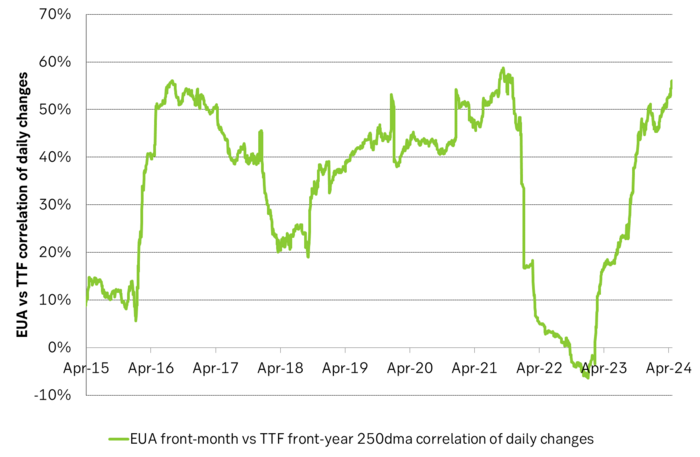
EUA price vs front-year TTF nat gas price since March 2023
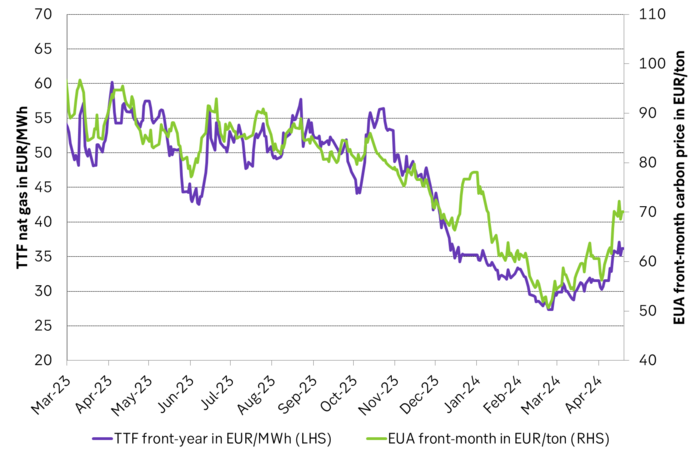
Front-month EUA price vs regression function of EUA price vs. nat gas derived from data from Apr to Nov last year.
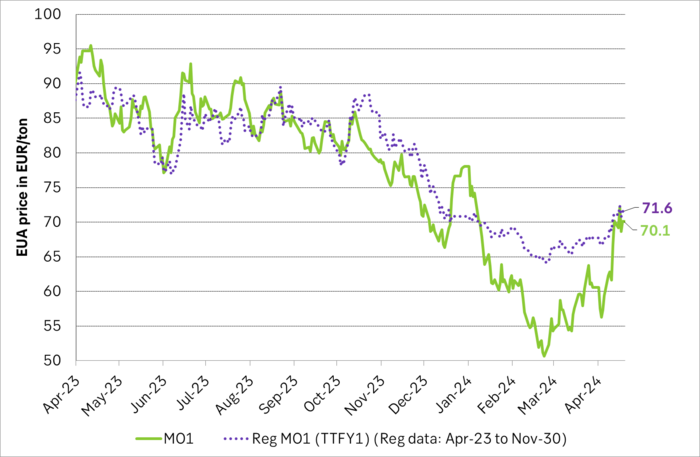
The EUA price vs the UKA price. Correlations previously, but not much any more.
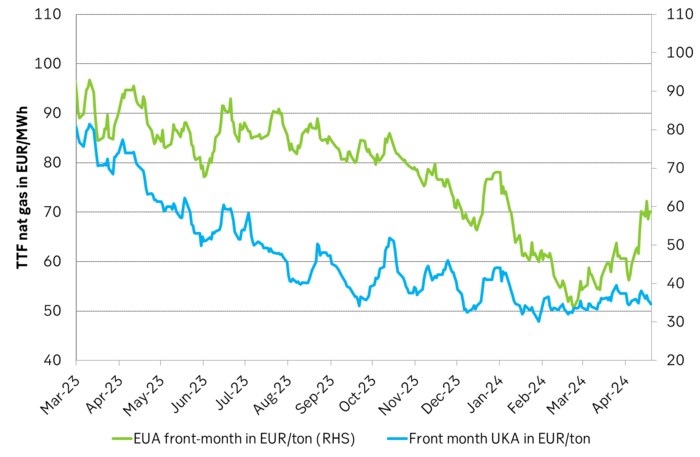
Forward German power prices versus clean cost of coal and clean cost of gas power. Coal is totally priced out vs power and nat gas on a forward 2026/27 basis.

Forward price of EUAs versus technical level where dynamical coal to gas flex typically takes place. EUA price for 2026/27 is at a level where there is no longer any price dynamical interaction or flex between coal and nat gas. The EUA price should/could then start to be negatively correlated to nat gas.

Forward EAU price vs. BNEF base model run (look for new update will come in late April), SEB’s EUA price forecast.
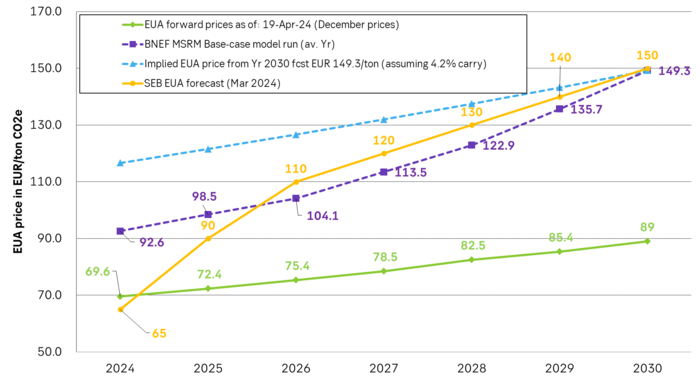
Analys
Fear that retaliations will escalate but hopes that they are fading in magnitude

Brent crude spikes to USD 90.75/b before falling back as Iran plays it down. Brent crude fell sharply on Wednesday following fairly bearish US oil inventory data and yesterday it fell all the way to USD 86.09/b before a close of USD 87.11/b. Quite close to where Brent traded before the 1 April attack. This morning Brent spiked back up to USD 90.75/b (+4%) on news of Israeli retaliatory attack on Iran. Since then it has quickly fallen back to USD 88.2/b, up only 1.3% vs. ydy close.

The fear is that we are on an escalating tit-for-tat retaliatory path. Following explosions in Iran this morning the immediate fear was that we now are on a tit-for-tat escalating retaliatory path which in the could end up in an uncontrollable war where the US unwillingly is pulled into an armed conflict with Iran. Iran has however largely diffused this fear as it has played down the whole thing thus signalling that the risk for yet another leg higher in retaliatory strikes from Iran towards Israel appears low.
The hope is that the retaliatory strikes will be fading in magnitude and then fizzle out. What we can hope for is that the current tit-for-tat retaliatory strikes are fading in magnitude rather than rising in magnitude. Yes, Iran may retaliate to what Israel did this morning, but the hope if it does is that it is of fading magnitude rather than escalating magnitude.
Israel is playing with ”US house money”. What is very clear is that neither the US nor Iran want to end up in an armed conflict with each other. The US concern is that it involuntary is dragged backwards into such a conflict if Israel cannot control itself. As one US official put it: ”Israel is playing with (US) house money”. One can only imagine how US diplomatic phone lines currently are running red-hot with frenetic diplomatic efforts to try to defuse the situation.
It will likely go well as neither the US nor Iran wants to end up in a military conflict with each other. The underlying position is that both the US and Iran seems to detest the though of getting involved in a direct military conflict with each other and that the US is doing its utmost to hold back Israel. This is probably going a long way to convince the market that this situation is not going to fully blow up.
The oil market is nonetheless concerned as there is too much oil supply at stake. The oil market is however still naturally concerned and uncomfortable about the whole situation as there is so much oil supply at stake if the situation actually did blow up. Reports of traders buying far out of the money call options is a witness of that.
-

 Nyheter3 veckor sedan
Nyheter3 veckor sedanGuldpriset når nytt all time high och bryter igenom 2300 USD
-

 Nyheter4 veckor sedan
Nyheter4 veckor sedanLundin Mining får köprekommendation av BMO
-

 Nyheter4 veckor sedan
Nyheter4 veckor sedanVertikal prisuppgång på kakao – priset toppar nu 9000 USD
-

 Nyheter3 veckor sedan
Nyheter3 veckor sedanCentralbanker fortsatte att köpa guld under februari
-

 Nyheter2 veckor sedan
Nyheter2 veckor sedanUSAs stigande konsumtion av naturgas
-

 Nyheter3 veckor sedan
Nyheter3 veckor sedanKakaomarknaden är extrem för tillfället
-

 Nyheter3 veckor sedan
Nyheter3 veckor sedanHur mår den svenska skogsbraschen? Två favoritaktier
-

 Nyheter4 veckor sedan
Nyheter4 veckor sedanBoliden på 20 minuter


